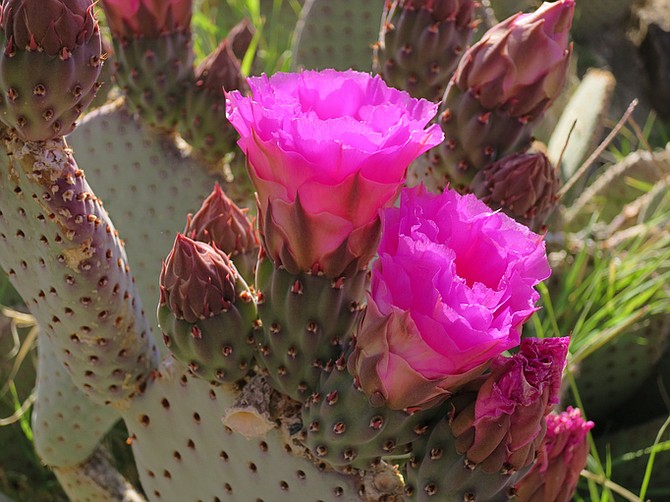 Facebook
Facebook
 X
X
 Instagram
Instagram
 TikTok
TikTok
 Youtube
Youtube

The Anza-Borrego Desert State Park flowers best this month, with peak blooms expected early in the month in low-lying, warm areas like Borrego Valley, the Borrego Badlands, Coyote Canyon, and along Highway S-2 in the south end of the park. Among the many annually appearing wildflowers you’ll find in the low-lying areas are desert sunflower, dune primrose, lupine, desert chicory, sand verbena, and desert lily. On slightly higher ground and up along the hillsides, you’ll spot blooming brittlebush, chuparosa, ocotillo, apricot mallow, and more. Starting in midmonth, several varieties of cactus should explode into bloom. For the latest update on this season’s bloom cycle, call Anza-Borrego Desert State Park’s desert-flower hotline, 760-767-4684, for a recorded message.
March Is the Proverbial Windy Month here in San Diego, as it is in many places. From midday to late afternoon, sun-warmed air expands and rises over the county’s interior, drawing in an influx of cool air from the coast to replace it. These afternoon sea breezes will continue at peak strength until well into the summer, providing dependable conditions for such sports as sailing, kite flying, and parasailing.
Mexican Coral Trees or “naked corals” are showing their stuff this season by bearing and baring scarlet, flame-like flowers on the tips of their twisting, leafless branches. Commonly planted as park and freeway landscaping, this and other species of coral are blooming along Freeway 94, Interstate 5 through Oceanside, along Harbor Drive near the airport, at the San Diego Zoo, on the lawns in front of San Diego City College downtown, and on the San Diego State University campus. The bloom may continue into late spring, when the naked corals will cover themselves with eight-inch-long leaves, just in time to provide shade for the warm months.
Ornamental Peach Trees, with radiant white and pink blossoms, are lighting up the manicured landscape around Sixth Avenue and Laurel Street in Balboa Park. These and other “stone-fruit” trees, with and without edible fruits, belong to the genus Prunus. Several native Prunus species contribute to San Diego County’s natural vegetation as well, among them hollyleaf cherry, choke cherry, desert almond, and desert apricot. The desert apricot, now blooming on the rocky hillsides of the Anza-Borrego Desert, attracts swarms of bees with its sweet-smelling nectar.


The Anza-Borrego Desert State Park flowers best this month, with peak blooms expected early in the month in low-lying, warm areas like Borrego Valley, the Borrego Badlands, Coyote Canyon, and along Highway S-2 in the south end of the park. Among the many annually appearing wildflowers you’ll find in the low-lying areas are desert sunflower, dune primrose, lupine, desert chicory, sand verbena, and desert lily. On slightly higher ground and up along the hillsides, you’ll spot blooming brittlebush, chuparosa, ocotillo, apricot mallow, and more. Starting in midmonth, several varieties of cactus should explode into bloom. For the latest update on this season’s bloom cycle, call Anza-Borrego Desert State Park’s desert-flower hotline, 760-767-4684, for a recorded message.
March Is the Proverbial Windy Month here in San Diego, as it is in many places. From midday to late afternoon, sun-warmed air expands and rises over the county’s interior, drawing in an influx of cool air from the coast to replace it. These afternoon sea breezes will continue at peak strength until well into the summer, providing dependable conditions for such sports as sailing, kite flying, and parasailing.
Mexican Coral Trees or “naked corals” are showing their stuff this season by bearing and baring scarlet, flame-like flowers on the tips of their twisting, leafless branches. Commonly planted as park and freeway landscaping, this and other species of coral are blooming along Freeway 94, Interstate 5 through Oceanside, along Harbor Drive near the airport, at the San Diego Zoo, on the lawns in front of San Diego City College downtown, and on the San Diego State University campus. The bloom may continue into late spring, when the naked corals will cover themselves with eight-inch-long leaves, just in time to provide shade for the warm months.
Ornamental Peach Trees, with radiant white and pink blossoms, are lighting up the manicured landscape around Sixth Avenue and Laurel Street in Balboa Park. These and other “stone-fruit” trees, with and without edible fruits, belong to the genus Prunus. Several native Prunus species contribute to San Diego County’s natural vegetation as well, among them hollyleaf cherry, choke cherry, desert almond, and desert apricot. The desert apricot, now blooming on the rocky hillsides of the Anza-Borrego Desert, attracts swarms of bees with its sweet-smelling nectar.
Comments